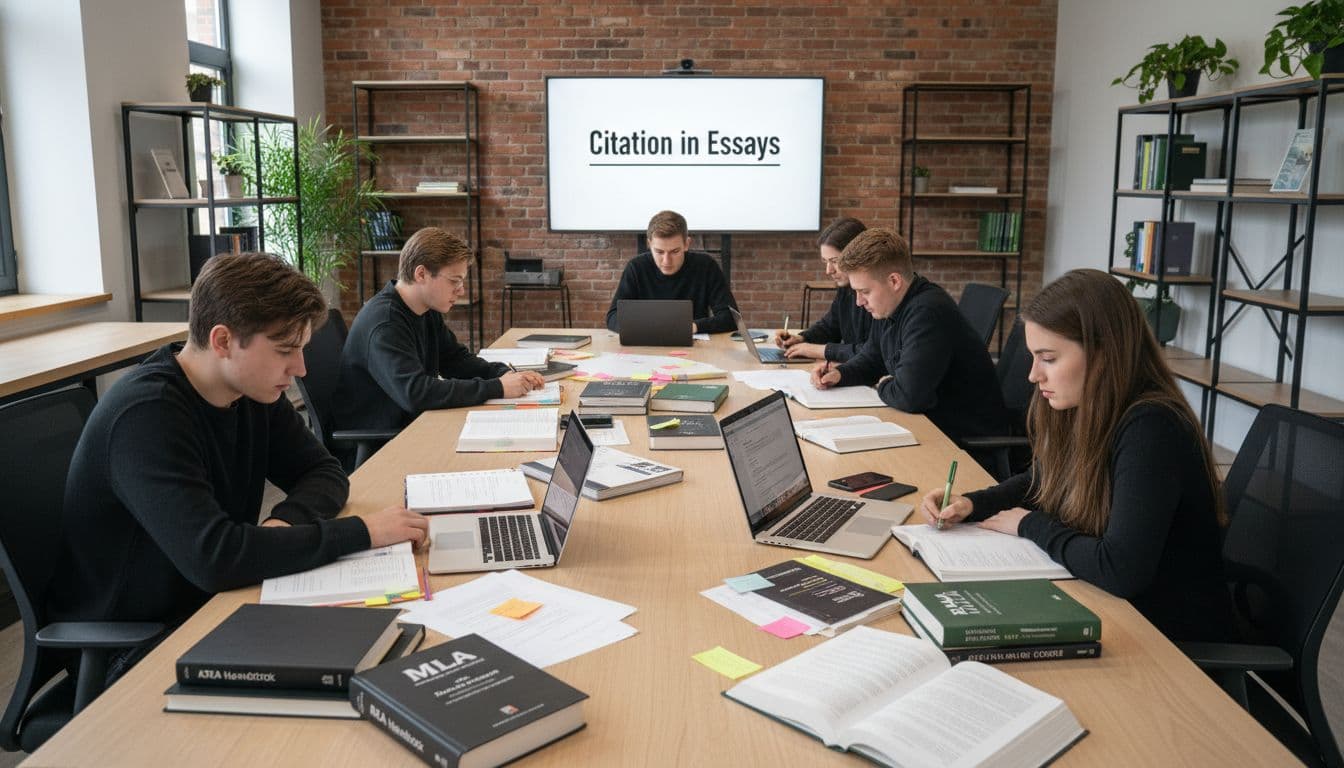Blog
Learning Materials
Citation in Essays: Complete Guide for Students
Updated: November 5, 2025

Over 80 percent of university students admit they feel stressed about proper citation when writing academic essays. Mistakes in referencing can mean lost marks or even accusations of plagiarism, so understanding citation is more than following rules—it protects your academic reputation. This guide makes citation clear by explaining its purpose, showing you key styles, and offering tips for accurate and ethical referencing.
Table of Contents
- Defining Citation In Academic Essays
- Major Citation Styles And Key Differences
- How To Cite Sources Effectively
- Best Practices For Accurate Referencing
- Common Citation Errors To Avoid
Key Takeaways
| Point | Details |
|---|---|
| Importance of Citation | Citation is crucial for academic integrity, providing credibility and recognition to original sources. |
| Major Citation Styles | Different academic disciplines prefer specific citation styles like MLA, APA, and Chicago, each with unique rules. |
| Methods of Citing Sources | Effective citation includes direct quotations, paraphrasing, and summarizing, always ensuring proper attribution. |
| Common Errors | Avoid incomplete source information and unethical practices like coercive citation to maintain academic integrity. |
Defining Citation in Academic Essays
Citation in academic writing is a fundamental practice that serves as a crucial bridge between intellectual discourse and academic integrity. According to Wikipedia, a citation is an "abbreviated alphanumeric expression embedded in the body of an intellectual work, denoting an entry in the bibliographic references section" that acknowledges the relevance of others' intellectual contributions.
At its core, citation is more than just a technical requirement—it's a scholarly communication tool that demonstrates intellectual honesty, provides credibility to your arguments, and gives proper recognition to the original sources of ideas and research. Taylor's Library emphasizes that a citation fundamentally "informs readers that certain material in your work originates from another source," making it an essential element of academic writing.
The primary purposes of citations in academic essays include:
- Giving credit to original authors and researchers
- Enabling readers to locate and verify your source materials
- Establishing the credibility and context of your research
- Demonstrating your engagement with existing scholarship
- Avoiding potential accusations of plagiarism
Effective citation requires precision and consistency. You'll need to follow specific style guidelines (such as APA, MLA, or Chicago) that dictate exactly how sources should be referenced both within the text and in the final bibliography. Mastering these techniques will not only improve your academic writing but also showcase your ability to engage critically and ethically with scholarly work.
For a comprehensive overview of different citation styles, check out our guide on types of in-text citation.
Major Citation Styles and Key Differences
Citation styles are not one-size-fits-all academic requirements. Research Guides highlight that different academic disciplines prefer specific citation formats, each with unique characteristics and presentation guidelines. Understanding these nuanced differences is crucial for producing professionally formatted academic work.
MLA (Modern Language Association) style is predominantly used in humanities disciplines like literature, language studies, and cultural analysis. Its hallmark features include:
- Author's last name and page number in parenthetical references
- Works Cited page at the document's end
- Emphasis on author's name and source's context
- More relaxed formatting compared to scientific citation styles
APA (American Psychological Association) style dominates social sciences, including psychology, education, and sociology. Its distinctive elements include:
- Author-date citation method
- Emphasis on publication year
- Detailed reference list with strict formatting rules
- Focus on scientific and research-oriented documentation
Chicago/Turabian style offers two primary documentation methods: notes-bibliography (common in history and arts) and author-date (used in sciences). This versatile style provides researchers with flexible citation approaches that can be adapted to various academic contexts.
Choosing the right citation style depends on your academic discipline, institutional requirements, and the specific guidelines of your research project or publication. While the core purpose remains consistent—giving proper credit and enabling source verification—each style offers a unique lens for presenting scholarly references.
Here's a comparison of key features and uses of major citation styles:
| Citation Style | Main Disciplines | In-Text Citation Format | Reference/Bibliography Page |
|---|---|---|---|
| MLA | Humanities | Author's last name & page number | Works Cited |
| APA | Social Sciences | Author's last name & year | Reference List |
| Chicago/Turabian | History Arts Sciences | Notes & Bibliography or Author-Date | Bibliography or Reference List |
How to Cite Sources Effectively
Citing sources effectively is an essential skill that goes beyond simply inserting references into your academic work. Taylor's Library emphasizes that incorporating others' ideas requires careful consideration, whether you choose to quote, paraphrase, or summarize—always ensuring proper attribution.
There are three primary methods of incorporating source material into your academic writing:
- Direct Quotation
- Use exact words from the original source
- Enclose the text in quotation marks
- Include page numbers for precise location
- Keep quotes concise and relevant to your argument
- Paraphrasing
- Restate the original idea in your own words
- Maintain the original meaning
- Completely rephrase the content
- Cite the source even when not using direct quotes
- Summarizing
- Condense the main ideas of a longer text
- Use your own language to capture key points
- Significantly shorten the original content
- Provide a citation to credit the original source
Research Guides highlight the importance of understanding specific guidelines for in-text citations and reference lists. Each citation style has unique requirements, so familiarize yourself with the specific rules of your chosen style. Consistency is key—pay attention to details like punctuation, formatting, and the order of information in your citations.
Remember, effective citation is more than a technical requirement. It's a way to demonstrate academic integrity, show the depth of your research, and give proper credit to the scholars and researchers who have contributed to your field of study.

Best Practices for Accurate Referencing
Accurate referencing is the cornerstone of scholarly writing, requiring meticulous attention to detail and systematic documentation. Taylor's Library emphasizes the critical importance of maintaining consistency and precision throughout your research process, ensuring every source is tracked and properly credited.
To develop robust referencing skills, consider these essential strategies:
- Source Management
- Keep detailed notes for every source you consult
- Record full bibliographic information immediately
- Use citation management tools or spreadsheets
- Create a systematic filing system for research materials
- Verification Techniques
- Double-check all source details before final submission
- Confirm page numbers, publication dates, and author names
- Cross-reference multiple sources when possible
- Verify digital sources are from reliable, academic platforms
- Style Guide Adherence
- Research Guides recommend utilizing official style guides specific to your academic discipline
- Download and reference the most current version of your chosen citation style manual
- Pay attention to minute formatting details
- Understand nuanced rules for different source types
Maintaining academic integrity goes beyond simply following rules. It's about respecting intellectual contributions, demonstrating scholarly rigor, and creating a transparent research ecosystem where ideas can be traced, verified, and built upon. Treat each citation as a professional acknowledgment of the knowledge that has informed your work.

Common Citation Errors to Avoid
Wikipedia highlights that academic integrity hinges on proper attribution, making it crucial to understand and avoid common citation pitfalls. Incorrect citations can unintentionally undermine the credibility of your research and potentially lead to accusations of academic misconduct.
The most frequent citation errors students encounter include:
- Incomplete Source Information
- Missing publication dates
- Incorrect author names
- Incomplete bibliographic details
- Failing to track original source locations
- Improper Paraphrasing
- Copying source text too closely
- Not using quotation marks for direct quotes
- Failing to cite paraphrased content
- Misrepresenting the original source's meaning
- Unethical Citation Practices
- Wikipedia warns about coercive citation, an unethical practice where citations are artificially manipulated
- Adding unnecessary references to inflate academic credentials
- Citing sources without actually reading them
- Using outdated or irrelevant sources
For students looking to master proper citation techniques, consulting specific MLA citation guidelines can provide additional clarity and help you navigate the nuanced world of academic referencing. Remember, citation is more than a technical requirement—it's a fundamental aspect of scholarly communication and intellectual respect.
Master Your Essay Citations with Smart Academic Tools
Struggling to keep your citations accurate and consistent while ensuring your essays remain original and well-structured can be overwhelming. This guide highlights the crucial challenges students face such as avoiding plagiarism, mastering various citation styles like MLA and APA, and maintaining academic integrity. Whether you find citing sources complicated or worry about formatting errors, Samwell.ai is designed to ease these pain points by offering precise, AI-powered essay generation and editing tools.

Don’t let citation errors hold you back. Use Samwell.ai to access powerful features like the Power Editor for perfecting your references and the Guided Essays that help you organize your research with proper attribution. Get real-time plagiarism checks that protect your integrity while saving you time. Start improving your academic writing now and see why over one million students trust Samwell.ai to boost their confidence and grades.
Frequently Asked Questions
What is the purpose of citation in academic essays?
Citation in academic essays serves multiple purposes, including giving credit to original authors, enabling readers to locate and verify sources, establishing credibility, and avoiding plagiarism.
What are the major citation styles used in academic writing?
The major citation styles include MLA (used in humanities), APA (used in social sciences), and Chicago/Turabian (used in history and certain arts and sciences), each with unique formatting and citation rules.
How can I cite sources effectively in my paper?
To cite sources effectively, you can use direct quotations, paraphrase original ideas in your own words, or summarize the main points, all while ensuring proper attribution according to your chosen citation style.
What are common citation errors to avoid when writing?
Common citation errors include incomplete source information, improper paraphrasing, and unethical citation practices such as coercive citation, which can compromise your academic integrity.
Generate essays with Samwell.ai
Whether you’re a publisher, professor, journalist, or student, let us tailor a plan just for you.Most Read Articles

Your Guide to Help Writing a Essay Successfully
Expert tips for help writing a essay - from crafting a thesis to structuring your essay effectively.

How to Write Critical Thinking Essay: Expert Tips
Expert tips for writing a critical thinking essay. Learn how to structure, choose topics, and use evidence effectively.'

How to Write a Good Hook: A Step-by-Step Guide
Master the art of crafting a good hook with our guide. Create compelling openers for a memorable first impression.
